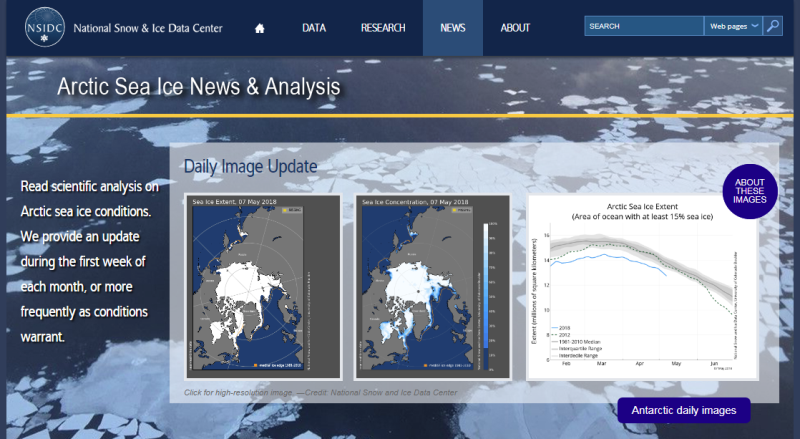File:Arctic Sea Ice News.png
Arctic_Sea_Ice_News.png (800 × 439 pixels, file size: 458 KB, MIME type: image/png)
The National Snow and Ice Data Center (NSIDC) supports research into our world’s frozen realms: the snow, ice, glaciers, frozen ground, and climate interactions that make up Earth’s cryosphere. NSIDC manages and distributes scientific data, creates tools for data access, supports data users, performs scientific research, and educates the public about the cryosphere.
Data management: We work to ensure that past, present, and future science data remain accessible for studying the Earth and its climate.
Scientific research: Scientists at NSIDC specialize in remote sensing of snow and ice, Arctic climate, frozen ground, ice sheets, glaciers, and more. Our researchers use the data products we offer, helping us better serve our research communities.
Experience: NSIDC began in 1976 as an analog archive and information center, the World Data Center for Glaciology. Since then, NSIDC has evolved to manage cryosphere-related data ranging from the smallest text file to terabytes of remote sensing data from NASA’s Earth Observing System satellite program. Read more about NSIDC history.
···············································································
In an interview with Yale Environment 360, polar scientist Mark Serreze talks about the rapid changes he has witnessed over more than three decades of working in the Arctic and the future stability of the region if temperatures continue to climb.
- https://e360.yale.edu/features/what-extremely-warm-winters-mean-for-the-future-of-the-arctic-serreze
e360: In your new book, you write that in the Arctic, “the forces of change seem to be unstoppable.” Do you really believe that?
Serreze: I think we’re destined for a seasonally ice-free Arctic Ocean right now. I don’t think we can stop that. There is too much heat in the pipeline already… and we are still very highly dependent on fossil fuels. Those greenhouse gas levels are going to continue to rise. Now, that does not mean [sea ice loss] cannot be reversed. In fact, there have been studies showing that if you could cool the climate down again, the sea ice in the Arctic would actually recover fairly quickly.
e360: What has it been like on a personal level watching this environment change over the course of your career?
Serreze: It’s frankly shocking… When you look at the Arctic, see what’s happened, you can watch it change before your eyes. That’s what I’ve done. When I first went up into the Arctic in 1982, I had no idea at all that we’d ever see something like this. Now, only 36 years later, and the Arctic of old is gone.
e360: If the region has changed this radically before your eyes in a mere 36 years, what do you expect it to look like at the end of this century?
Serreze: We’re going to have an Arctic that, except for winter, you look at it from satellite and it’s going to be a blue ocean. It will have lost its ice. Not just its sea ice, but a lot of the permafrost will be thawed, the snow cover season will be much shorter. The thing is, when you’re thinking about the Arctic, the Arctic’s soul is its ice. When you lose that ice, the Arctic loses its soul.
○
File history
Click on a date/time to view the file as it appeared at that time.
| Date/Time | Thumbnail | Dimensions | User | Comment | |
|---|---|---|---|---|---|
| current | 16:42, 8 May 2018 |  | 800 × 439 (458 KB) | Siterunner (talk | contribs) |
You cannot overwrite this file.
File usage
The following 2 pages use this file:
